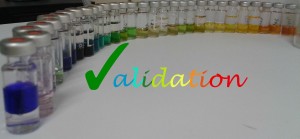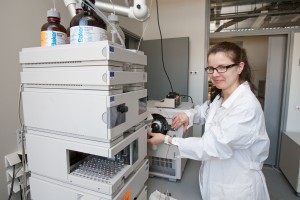 The LC-MS group at the UT Institute of Chemistry were recently invited by the journal Analytica Chimica Acta to write a tutorial review on the topic of validation of liquid chromatography mass spectrometry (LC-MS) methods. This work has now been completed. The tutorial review intends to give an overview of the state of the art of method validation in liquid chromatography mass spectrometry (LC–MS), especially with electrospray ionisation (LC-ESI-MS), and discuss specific issues that arise with MS (and MS-MS) detection (i.e. LC-MS-MS) in LC (as opposed to the “conventional” detectors). The review was eventually split in two parts (because of its large volume):
The LC-MS group at the UT Institute of Chemistry were recently invited by the journal Analytica Chimica Acta to write a tutorial review on the topic of validation of liquid chromatography mass spectrometry (LC-MS) methods. This work has now been completed. The tutorial review intends to give an overview of the state of the art of method validation in liquid chromatography mass spectrometry (LC–MS), especially with electrospray ionisation (LC-ESI-MS), and discuss specific issues that arise with MS (and MS-MS) detection (i.e. LC-MS-MS) in LC (as opposed to the “conventional” detectors). The review was eventually split in two parts (because of its large volume):
- Tutorial review on validation of liquid chromatography–mass spectrometry methods: Part I. A. Kruve, R. Rebane, K. Kipper, M.-L. Oldekop, H. Evard, K. Herodes, P. Ravio, I. Leito. Anal. Chim. Acta 2015, 870, 29-44
- Tutorial review on validation of liquid chromatography–mass spectrometry methods: Part II. A. Kruve, R. Rebane, K. Kipper, M.-L. Oldekop, H. Evard, K. Herodes, P. Ravio, I. Leito. Anal. Chim. Acta 2015, 870, 8-28
(as an April joke from Elsevier, part II appears page-wise before part I)
The review addresses and compares all the major validation guidelines published by international organizations: ICH, IUPAC, AOAC, FDA, EMA (EMEA), Eurachem, SANCO, NordVal, European Commission Decision 2002/657/EC. With every performance characteristic the tutorial review briefly compares the recommendations of the guidelines.
The Part I briefly introduces the principles of operation of LC–MS (emphasizing the aspects important from the validation point of view, in particular the ionization process and ionization suppression/enhancement); reviews the main validation guideline documents and discusses in detail the following performance parameters: selectivity/specificity/identity, ruggedness/robustness, limit of detection, limit of quantification, decision limit and detection capability. The Part II starts with briefly introducing the main quantitation methods and then addresses the performance related to quantification: linearity of signal, sensitivity, precision, trueness, accuracy, stability and measurement uncertainty. The last section of Part II is devoted to practical considerations in validation and a possible step by step validation plan specifically suitable for LC-MS-MS is presented.
With every method performance characteristic its essence and terminology are addressed, the current status of treating it is reviewed and recommendations are given, how to determine it, specifically in the case of LC–MS methods. In many cases the published guidelines remain too general for practicing analyst. This tutorial review gives more specific advice based on the best available practice.

Based on the recommended approaches presented in this tutorial review an LC-MS validation software ValChrom is currently under development by the UT team. The software development is supported by the EU Regional Development Fund (Development of software for validation of chromatographic methods, Project No. 3.2.1201.13-0020).
 Mass spectrometry is currently probably the No 1 technique for determining trace-level components in complex (especially biomed-related) mixtures. The key issues in such applications are sample preparation, sample introduction to MS and ionization of components of interest (analytes). Big efforts are continually made to improve any of them.
Mass spectrometry is currently probably the No 1 technique for determining trace-level components in complex (especially biomed-related) mixtures. The key issues in such applications are sample preparation, sample introduction to MS and ionization of components of interest (analytes). Big efforts are continually made to improve any of them.




